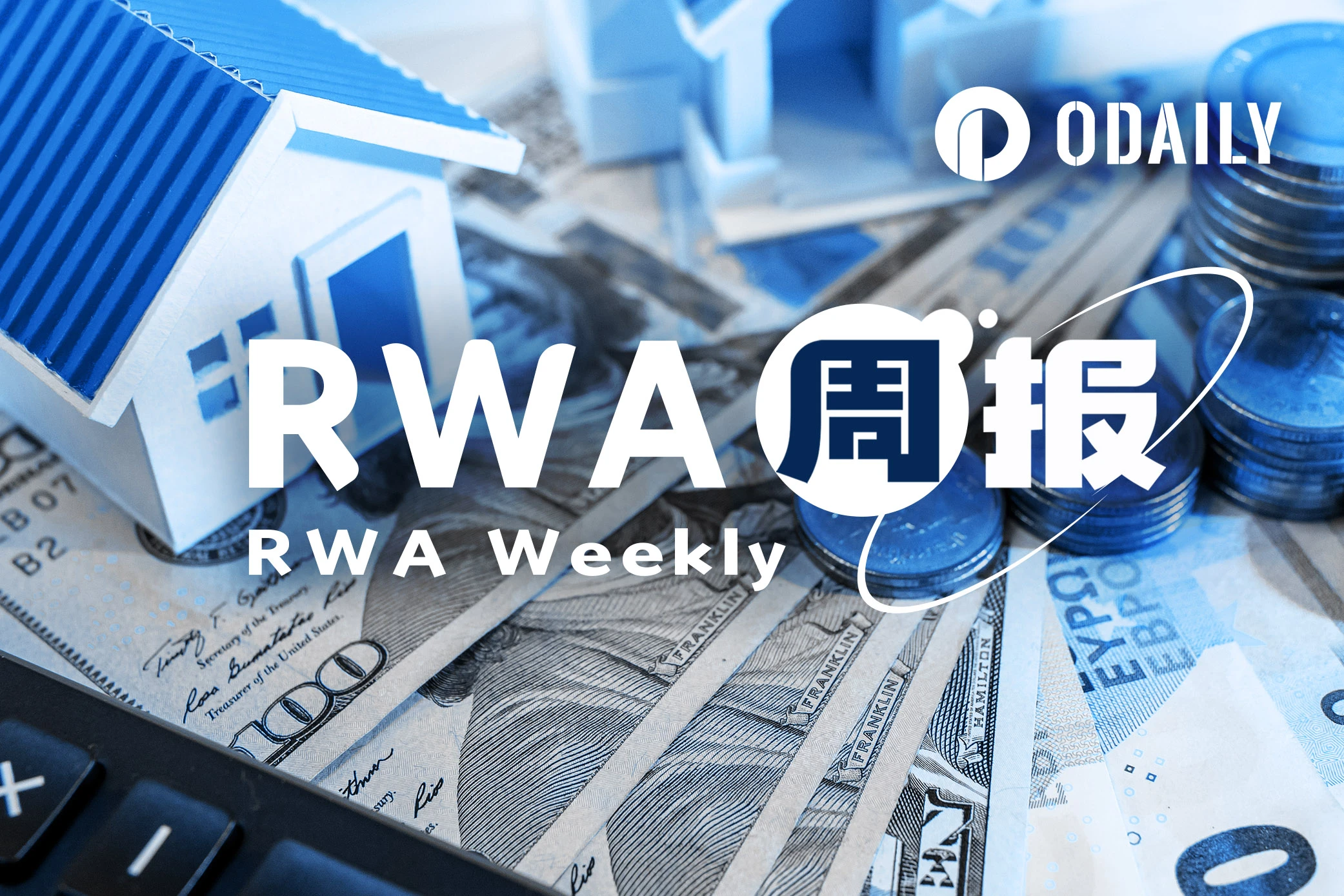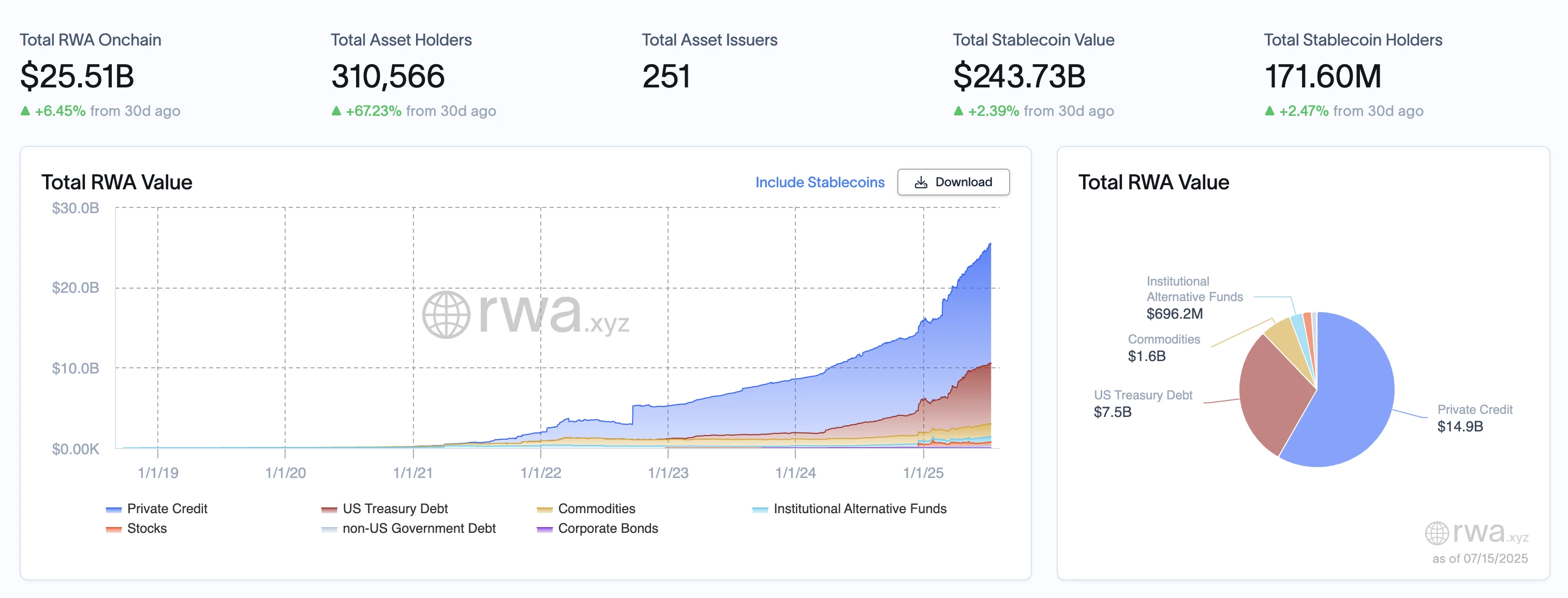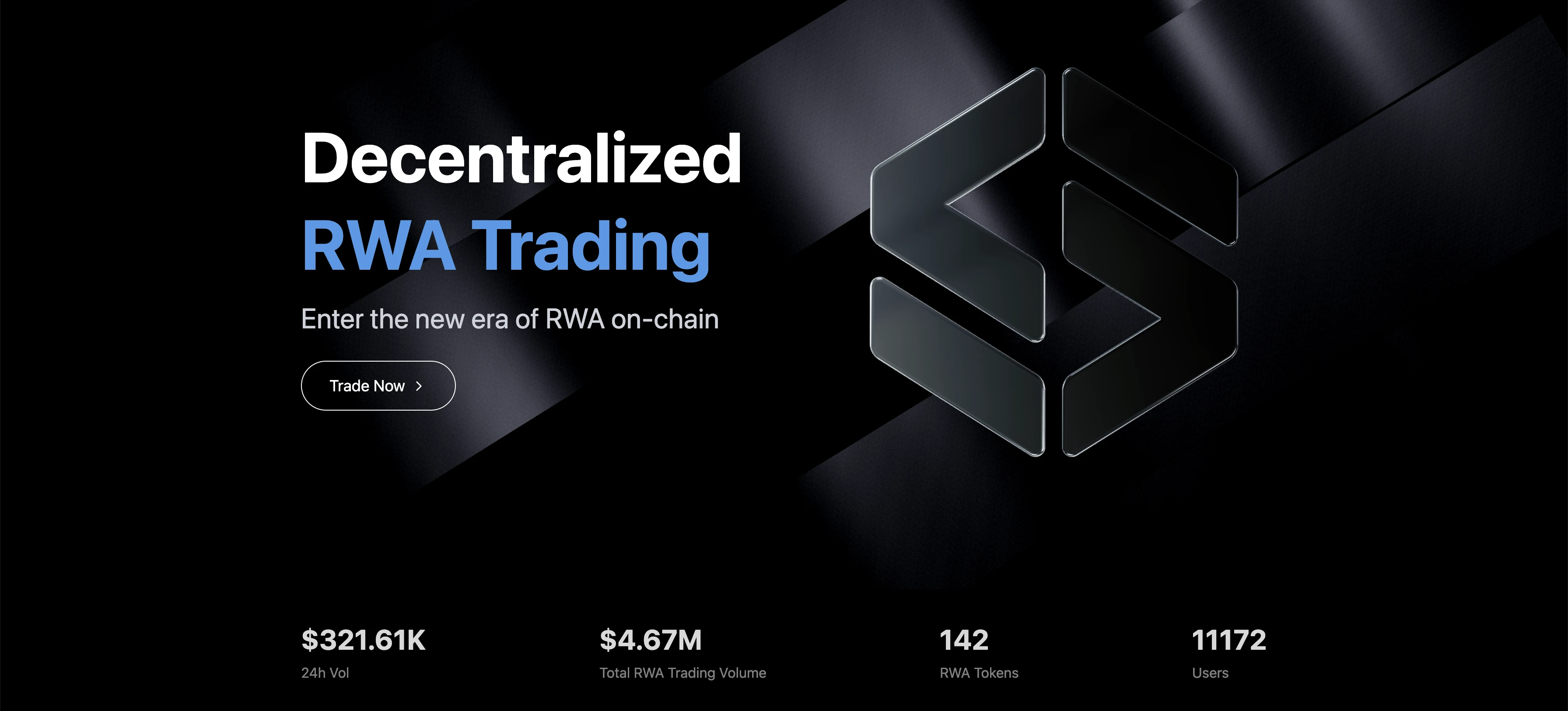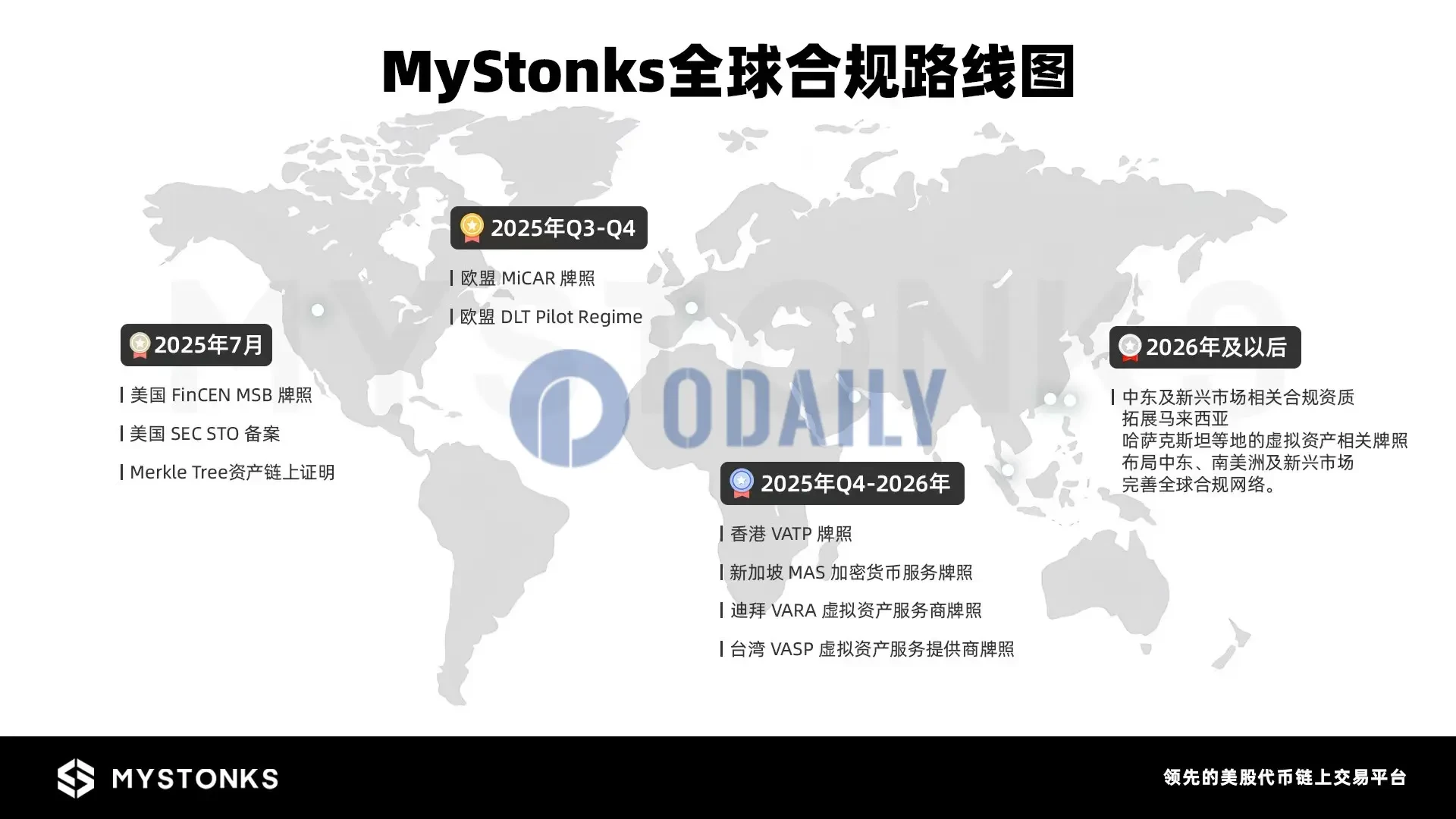Original | Odaily Planet Daily ( @OdailyChina )
Author | Ethan ( @ethanzhang_web3 )

RWA Sector Market Performance
According to the latest data from RWA.xyz, as of July 15, 2025, the total value of RWA on the chain has reached US$25.51 billion, an increase of approximately US$990 million from US$24.52 billion on July 8, an increase of approximately 4.04%. The total number of on-chain asset holders jumped from 285,260 to 310,566, a weekly increase of more than 25,000, an increase of approximately 8.9%. The number of asset issuers also increased from 249 to 251, with 2 new issuers. In terms of the stablecoin ecosystem, the total value of stablecoins increased from US$241.58 billion to US$243.73 billion, an increase of approximately 0.89%; the number of stablecoin holders increased from 170.35 million to 171.60 million, a continued increase of 0.73%.
From the perspective of asset structure, private credit rebounded strongly this week, increasing from $14.1 billion to $14.9 billion, with an increase of $800 million in a week, bringing a new round of upward momentum to the dominant category. U.S. Treasury bonds remained stable at $7.5 billion, with no significant changes. Commodity assets remained at $1.6 billion, with no changes for the third consecutive week, and the market is still in a wait-and-see mood. Institutional alternative funds increased from $553 million to $696.2 million, a sharp increase, with a weekly increase of more than $140 million, becoming another significant growth point this week.
What is the trend (compared to last week )?
The market value on the chain rebounded strongly, and the momentum of user growth continued to be released: After a slow upward trend in the second half of June, the market value of RWA increased by more than 4% this week, and the number of users climbed sharply to 310,000 again . The market is re-entering an active expansion cycle, and the ecological attractiveness continues to increase. Funds flowed back to high-yield assets, and private credit led the rise again: Private credit rebounded strongly after a short-term adjustment, with a net increase of US$800 million in a single week . The market risk appetite rebounded in stages, and investors rekindled their interest in high-yield products on the chain. Alternative funds have emerged, and the signal of structural diversification is obvious: Alternative funds grew by more than 26% in a week , institutional funds have participated more, and asset portfolio allocation is becoming more diversified.
The current RWA market has entered a stage of structural expansion + recovery in risk appetite. It is recommended to dynamically adjust the allocation strategy from the following aspects: continue to focus on allocating private credit assets, which are suitable for priority when there is a strong pursuit of returns. The allocation value is enhanced under the current rebound trend; strengthen attention to and screening of alternative assets. Institutional funds may have been deployed in advance, and such assets may become an important structural supplement in the future; stable assets such as U.S. Treasuries continue to serve as basic positions to provide a defensive buffer when volatility returns; pay close attention to new issuers and the launch of new product categories. The current market has the basic conditions to accept more innovative assets.
In general, the RWA market has restarted its growth engine in mid-July 2025. Driven by the rebound of high-yield assets and the resonance of user inflows, the on-chain asset structure continues to optimize. It is expected that in the next few weeks, we will enter a window period of incremental asset launch and multi-asset resonance expansion. We should remain sensitive to changes in the on-chain structure and act when the time is right.

Review of key events
U.S. SEC Commissioner Hester Peirce wrote that tokenized securities are still securities in essence, so market participants must fully consider and strictly comply with federal securities regulations when trading such instruments.
Securities tokenization may be implemented by the issuer itself, for example, an industrial company or investment company can tokenize its shares; it may also be operated by a custodian that holds securities issued by a third party. Such institutions may issue tokens linked to their custodial securities, or tokenize the security rights that investors enjoy in the custodian. Buyers of such third-party tokens may face special risks such as unique counterparty risks.
Issuers of tokenized securities must fulfill the information disclosure obligations required by federal securities laws. Market participants should carefully evaluate the legal attributes of these securities and their corresponding regulatory requirements when distributing, purchasing and trading tokenized securities.
Market participants are advised to proactively communicate with the CSRC and its staff when designing tokenized product solutions. When technical characteristics do require adjustments to current rules, or regulatory requirements are outdated, the SEC is willing to work with the industry to develop reasonable exemption clauses to promote the regulatory framework to keep pace with the times.
Cayman Islands proposes to amend law to clarify regulatory boundaries for tokenized funds
The Cayman Islands has proposed the Virtual Asset Service Providers (Amendment) Bill 2025, which intends to amend the definition of virtual asset issuance in the VASP Act to explicitly exclude financial instruments such as tokenized fund interests and equity. This amendment will prevent tokenized funds from being subject to dual regulation by the VASP Act and the Funds Act, reducing the compliance burden. If passed, the new regulations will have retroactive effect, provide legal certainty for existing tokenized funds, and strengthen Caymans leading position in the RWA tokenization field.
Ant Financial’s Jovay launches testnet, mainnet to be launched in Q4
On July 15, the Jovay testnet was officially launched. As a blockchain platform built by Ant Digits for institutional-level application scenarios, it aims to serve various application scenarios including RWA. Jovay solves the core pain points of traditional Layer 2 solutions in performance, security, compliance and scalability through three technologies: parallel execution architecture, progressive hybrid verification mechanism and modular architecture, making large-scale high-frequency transactions on the chain possible. It is understood that Jovay plans to complete the mainnet launch in the fourth quarter of 2025.
It is reported that Jovay can significantly improve throughput while shortening user response time to less than 1 second through a three-layer pipeline parallel architecture at the transaction level, block level, and batch level, ensuring the real-time performance of scenarios such as transfers and RWA contract calls.
In response to the problems of traditional Rollup solutions such as long verification time and delayed dispute period, Jovay adopts a dual proof architecture system of trusted execution environment (TEE) and zero-knowledge proof (ZKP), which takes into account performance while reducing the trust dependence on centralized hardware. Jovay also adopts a modular architecture, which can independently upgrade each core module according to technological evolution.
YZi Labs invests in blockchain infrastructure platform Aspecta
YZi Labs announced a strategic investment in blockchain infrastructure platform Aspecta. The specific amount has not been disclosed. Aspecta is committed to providing intelligent authentication, price discovery and lifecycle liquidity for illiquid assets such as pre-TGE stocks, locked tokens, private equity, RWA, etc.
According to previous news , Aspecta is a selected project of Binance Labs seventh season accelerator program MVB VII. As an AI-driven platform, it is suitable for the new paradigm of developer economy and provides support for the development of individual developers and ecosystems.
Monad Foundation acquires stablecoin infrastructure project Portal
The Monad Foundation announced the acquisition of the stablecoin infrastructure project Portal. The specific acquisition amount has not been disclosed. Portal will continue to operate as an independent entity, but will use Monads technology to provide services to customers. Portal founder Raj Parekh will move to the Monad Foundation as the director of payments and stablecoins.
Matrixport Ventures: Completed XAUm strategic reserve worth $3 million
According to the official announcement, Matrixport Ventures announced that it has completed a strategic reserve of XAUm equivalent to US$3 million, and plans to continue to increase its holdings in stages based on market prices.
MembersCap Completes First Tokenized Reinsurance Fund Investment Deployment
Members Capital Management, a Bermuda-regulated investment firm, announced that its tokenized reinsurance fund MCM Fund I has completed initial investment deployment. The fund is the first tokenized reinsurance product for crypto and traditional institutional investors. The transaction was brokered by the worlds top three reinsurance brokers and worked with top institutions such as Lloyds Syndicate. The fund is based on Solana, Aptos, Cardano and Base, and has landed on the Archax platform RWA section, along with institutional products such as BlackRock.
Qianxun Technology (01640.HK) announced that it has reached a strategic cooperation with Shenzhen Aizuji Technology Co., Ltd. (Aizuji) on July 15. The two parties will rely on RWA and blockchain technology to jointly create 3C leasing asset tokenization products in the field of mobile phone and tablet leasing.
Hot Project Dynamics
MyStonks(STONKS)

One sentence introduction:
MyStonks is a community-driven DeFi platform that focuses on tokenizing RWAs such as US stocks and trading them on the chain. The platform works with Fidelity to achieve 1:1 physical custody and token issuance. Users can use stablecoins such as USDC, USDT, USD1, etc. to mint stock tokens such as AAPL.M and MSFT.M, and buy and sell them around the clock on the Base blockchain. All transactions, minting and redemption processes are executed by smart contracts to ensure transparency, security and auditability. MyStonks is committed to breaking through the boundaries between TradFi and DeFi, providing users with a high-liquidity, low-threshold on-chain investment portal for US stocks, and building a NASDAQ of the crypto world.
Latest News:
On July 9, MyStonks announced that the platform had obtained the MSB (Money Services Business) license issued by the Financial Crimes Enforcement Network (FinCEN) of the U.S. Treasury Department , and officially obtained the qualification to operate in compliance with regulations in the United States and its overseas territories.
On July 10, MyStonks officially released its global compliance roadmap . According to the roadmap, MyStonks will complete the US SEC Security Token Offering (STO) filing in July and launch the Merkle Tree asset chain proof mechanism to further enhance asset transparency and user trust.

On July 14, MyStonks announced that it would take a snapshot of all user accounts holding PG.M (Procter Gambles US stock token) at the close of July 18. Each user holding 1 PG.M token will receive a dividend of 1.0568 USDT, which will be automatically distributed to the MyStonks account on August 15, without any user intervention.
On July 15, MyStonks announced a strategic partnership with Web3 aggregation platform COPX . From now on, the two parties will start commission rebate cooperation through the invitation code system. Users who register MyStonks through COPX exclusive invitation code can enjoy platform rebates, and the commissions will be automatically returned to the users account in the form of tokens.
Ondo Finance (ONDO)

One sentence introduction:
Ondo Finance is a decentralized finance protocol that focuses on the tokenization of structured financial products and real-world assets. Its goal is to provide users with fixed-income products such as tokenized U.S. Treasuries or other financial instruments through blockchain technology. Ondo Finance allows users to invest in low-risk, highly liquid assets while maintaining decentralized transparency and security. Its token ONDO is used for protocol governance and incentive mechanisms, and the platform also supports cross-chain operations to expand its application scope in the DeFi ecosystem.
Latest News:
On July 11, Ondo Finance announced that its tokenized stock and ETF products will soon be launched on the Ethereum mainnet.
On July 14, Ondo Finance announced the acquisition of Strangelove , a blockchain development company related to blockchain infrastructure construction. The specific acquisition price has not been disclosed. The acquisition will expand Ondos engineering and product capabilities, enabling it to develop infrastructure to put RWA on the chain. On the same day, it was announced that BitgetWallet will support Ondos tokenized stocks, ETFs and other products when it is launched this summer.
Related links
Sort out the latest insights and market data for the RWA sector.
Cailianshe: Regarding stablecoins, urgent reminders from many places
Behind the stablecoin craze, chaos is occurring frequently, and emergency warnings have been issued in many places, revealing new methods of illegal fundraising. Investors must be wary of high-interest traps.
RWA: A financial revolution is about to break out
The main text is 7,000 words long and analyzes the value and trend of RWA from the perspective of the historical evolution and logic of asset financialization.










